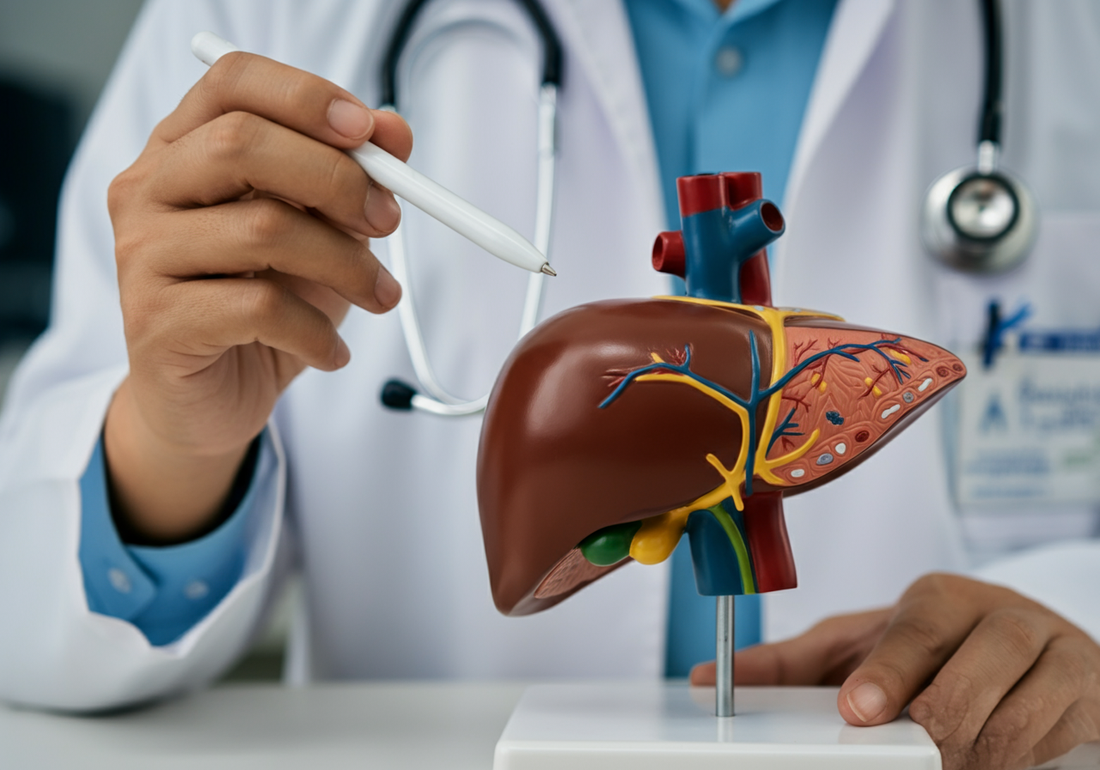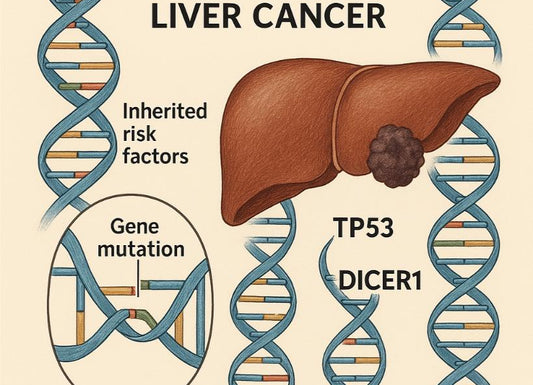Liver Biopsy: What It Is, When It’s Needed, and What to Expect
 Written By
Abel Tamirat, MD
Written By
Abel Tamirat, MD

A liver biopsy is a test that gives doctors important information about your liver health. It involves removing a small piece of liver tissue so it can be examined under a microscope. While it might sound intimidating, it's a common and safe procedure that helps guide treatment decisions.
This in-depth guide explains why liver biopsies are done, how they work, what risks to expect, and how to prepare and recover. Whether you’ve been told you need one or just want to learn, this article will help you understand the process from start to finish.
What is a liver biopsy?
A liver biopsy is a procedure that allows doctors to look directly at liver tissue. By examining a tiny sample under a microscope, doctors can:
-
Confirm a diagnosis
-
Assess liver damage
-
Check for scarring (fibrosis)
-
Look for fat buildup or inflammation
-
Detect abnormal cells or cancer
Biopsy can give answers that imaging tests (like ultrasound or MRI) cannot.
If you're curious whether liver function test results can still appear normal in cirrhosis, this guide explains how that's possible.
Why would a doctor recommend a liver biopsy?

A liver biopsy may be recommended when other tests don't give a full picture. Common reasons include:
-
Unexplained liver enzyme elevation
-
Suspected hepatitis B or C
-
Fatty liver disease (NAFLD or NASH)
-
Autoimmune liver disease
-
Iron or copper buildup (hemochromatosis, Wilson’s disease)
-
Monitoring fibrosis or cirrhosis
-
Checking the liver after a transplant
-
Evaluating a liver mass or lesion
Biopsy can also help assess how well a treatment is working.
Explore the Home Liver Test to see how at-home kits are making liver monitoring easier.
What are the different types of liver biopsy?
Doctors may choose the type of biopsy based on your health history, liver condition, and bleeding risk.
1. Percutaneous (through the skin)
-
Most common method
-
A needle is inserted between the ribs into the liver
-
Done with local anesthesia and imaging guidance
2. Transjugular (through a neck vein)
-
Used if you have a bleeding risk or fluid buildup
-
A catheter is passed into a vein in your neck and then into the liver
-
Less risk of bleeding into the abdominal cavity
3. Laparoscopic (during surgery)
-
Done when a direct view of the liver is needed
-
Used during planned surgeries or when other methods aren’t possible
-
Allows doctors to take samples from specific spots
Each type has its own benefits and risks. Your doctor will choose the safest option for you.
Learn more about the AFP test for liver, a common follow-up to biopsy when liver cancer is suspected.
How to prepare for a liver biopsy
Preparation helps reduce the risk of complications and makes the procedure smoother. You may be asked to:
-
Stop blood thinners (aspirin, ibuprofen, or anticoagulants)
-
Avoid food and drink for 6–8 hours before the procedure
-
Take a blood test to check clotting (INR) and platelet count
-
Arrange a ride home afterward
Tell your provider about:
-
Allergies or medications
-
Bleeding problems
-
Past surgeries or liver issues
-
If you're pregnant or trying to conceive
Not sure what a liver test might cost? Here’s a helpful breakdown of liver function test pricing.
What happens during a percutaneous liver biopsy?
-
You'll lie on your back or left side.
-
The doctor cleans and numbs your skin with local anesthesia.
-
An ultrasound or CT scan guides the needle to the right spot.
-
A thin needle is inserted through your skin to remove a small liver sample.
-
The procedure takes 15–30 minutes.
Most people feel slight pressure or a brief sting. The sample is sent to a lab for detailed analysis.
You can also explore how to reduce liver inflammation quickly using doctor-approved methods.
What happens during a transjugular liver biopsy?
-
You lie on your back in a hospital bed.
-
The doctor numbs the neck and inserts a thin tube into a neck vein.
-
The catheter is guided through veins into the liver.
-
A special needle is passed through the catheter to collect the tissue sample.
-
Imaging helps guide the process and reduce risks.
This method avoids puncturing the liver capsule directly, so bleeding is less likely.
If you're feeling liver pain or discomfort, find out what might be mistaken for liver pain.
What about laparoscopic liver biopsy?

Laparoscopic biopsy is done in an operating room or surgical setting. It may be part of another surgery or planned as a standalone procedure. It involves:
-
Small incisions in the abdomen
-
A camera to guide the biopsy
-
Targeted sampling from specific liver areas
Recovery depends on the type of anesthesia and the extent of surgery involved.
Wondering if liver cancer is curable? Read our comprehensive guide on liver cancer treatment outcomes.
What are the risks of a liver biopsy?
Liver biopsy is generally safe, but possible risks include:
-
Pain at the site (most common)
-
Bleeding inside the abdomen
-
Infection
-
Puncture of nearby organs (rare)
-
Reactions to anesthesia (if used)
Serious complications happen in less than 1–2% of cases. Your medical team will watch you closely after the test.
Call your provider if you notice:
-
Worsening pain
-
Bleeding or bruising
-
Fever or chills
-
Trouble breathing
To support your recovery, learn about the signs your liver is healing.
What should you expect after the biopsy?
After the biopsy, you’ll rest under observation:
-
Usually 2–4 hours for percutaneous biopsy
-
You may lie on your right side to prevent bleeding
-
Avoid strenuous activity for 24–48 hours
-
Most people go home the same day
Mild discomfort or soreness is common. Over-the-counter pain relievers (except NSAIDs) can help.
How long does it take to get results?
Most biopsy results are ready in a few days. Your provider will:
-
Review the sample under a microscope
-
Look for signs of inflammation, fat, fibrosis, or cancer
These results guide treatment decisions, lifestyle changes, or follow-up plans.
What can a liver biopsy diagnose?
A biopsy can help detect or confirm:
-
Hepatitis (viral or autoimmune)
-
NAFLD or NASH (fatty liver disease)
-
Cirrhosis or fibrosis
-
Iron or copper overload
-
Drug-induced liver injury
-
Liver cancer (hepatocellular carcinoma)
-
Transplant rejection
It can also help doctors understand how far liver disease has progressed.
Understanding what to expect post-biopsy is just as important as preparing for the procedure. Read about the AFP liver test if cancer markers are part of your evaluation.
Are there alternatives to liver biopsy?
Yes. In some cases, non-invasive tests can be used instead of, or before, a biopsy:
-
FibroScan (elastography): Uses sound waves to measure liver stiffness
-
MRI or MR elastography: Advanced imaging to assess liver tissue
-
Blood tests: Can estimate liver scarring or inflammation
While helpful, these tools don’t always replace biopsy—especially when the diagnosis is unclear.
How should you follow up after a liver biopsy?

Your follow-up plan depends on the biopsy results. Your provider might:
-
Start or adjust medications
-
Recommend lifestyle changes (diet, alcohol, weight)
-
Refer you to a liver specialist (hepatologist)
-
Schedule more tests or imaging
Make sure to ask about:
-
What the biopsy showed
-
What it means for your condition
-
What happens next
Common myths about liver biopsy
“It’s too risky.”
Liver biopsy is low-risk when done by experienced providers.
“It always means cancer.”
Most biopsies are done to check for inflammation or scarring, not cancer.
“It’s painful.”
You may feel pressure, but most people report only mild discomfort.
“There are better tests now.”
Non-invasive tests are helpful but don’t replace biopsy in every case.
Takeaway
A liver biopsy helps doctors see what’s really happening inside your liver. It’s a safe and important test when other tools don’t provide clear answers. The procedure is usually short, and recovery is fast. Results help confirm diagnoses, guide treatment, and monitor disease progression.
If your doctor recommends a biopsy, it’s because the benefits outweigh the risks. Ask questions, follow prep instructions, and take it one step at a time.
Want clear answers about your liver health? Explore our at-home liver health tools or sign up for our newsletter for tips, updates, and expert guidance.
Related Resources
References
Krans, B. (2021, February 2). Liver biopsy. Healthline; Healthline Media. https://www.healthline.com/health/liver-biopsy
Liver biopsy. (n.d.). Mayoclinic.org. Retrieved August 25, 2025, from https://www.mayoclinic.org/tests-procedures/liver-biopsy/about/pac-20394576
Liver biopsy. (2023, September 6). Cleveland Clinic. https://my.clevelandclinic.org/health/procedures/9503-liver-biopsy
Pandey, N., Hoilat, G. J., & John, S. (2025). Liver biopsy. In StatPearls. StatPearls Publishing.
(N.d.-a). Medscape.com. Retrieved August 25, 2025, from https://emedicine.medscape.com/article/1819437-overview
(N.d.-b). Sciencedirect.com. Retrieved August 25, 2025, from https://www.sciencedirect.com/topics/medicine-and-dentistry/liver-biopsy

Dr. Abel Tamirat is a licensed General Practitioner and ECFMG-certified international medical graduate with over three years of experience supporting U.S.-based telehealth and primary care practices. As a freelance medical writer and Virtual Clinical Support Specialist, he blends frontline clinical expertise with a passion for health technology and evidence-based content. He is also a contributor to Continuing Medical Education (CME) programs.



